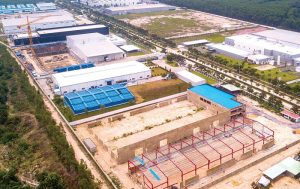Amid the surge in e-commerce and the scarcity of land, multi-storey warehouses and factories are increasingly becoming popular.
According to the latest CBRE report, over the past decade, Vietnam has emerged as a major manufacturing hub regionally and globally. Additionally, the domestic market’s consumer spending is robust and is expected to maintain growth momentum in the coming years, especially in the e-commerce sector.
From 2016 to 2021, Vietnam’s e-commerce grew by 25% per year, with many major retail players planning expansion and increased investment.

Multi-storey Warehouses/Factories Optimize Land Use
The demand for warehouses/factories is significant. Currently, the vacancy rate of industrial real estate nationwide is relatively low, with industrial land at 8% and warehouses/factories at 10%. The limited supply of industrial land can lead to a supply-demand imbalance, prompting the development of multi-storey warehouse/factory models.
The main advantage of multi-storey warehouses/factories is optimizing land use and increasing the business and production efficiency of enterprises. These facilities are often equipped with ramps, cargo elevators, or conveyor systems, with ramps playing a crucial role in facilitating easy and efficient transportation of goods to higher floors.
Multi-storey warehouse/factory models are common in Asian markets like Hong Kong, Singapore, Tokyo, Osaka, and Shanghai, where production activities are robust and create significant demand for rental space. In the context of increasingly scarce land and rising rental prices, these models are the key to addressing supply-demand imbalances. This trend is now spreading to Europe, America, and Australia, offering advantages over traditional models.
In Vietnam, the first multi-storey factory was built in 2015 at the Tan Thuan Export Processing Zone in Ho Chi Minh City. Since then, the market has welcomed 15 projects, providing over 900,000 m2 of rental space. In the next three years, the total supply of multi-storey warehouses/factories is expected to double with 10 new projects.
The demand for warehouses/factories remains high amidst shrinking land availability and soaring rental prices. The rise in e-commerce has also increased the demand for quick delivery services, but the scarcity of large rental areas near residential zones poses challenges in supply chain management and operation.
For tenants, location and accessibility are key factors in rental decisions. Multi-storey warehouses/factories, maximizing land use efficiency, have become a suitable choice for businesses to adapt to market dynamics and meet customer needs.
E-commerce businesses often require large warehouse space for storing various items and installing equipment for picking, packing, and reverse logistics operations. Thus, multi-storey warehouses are ideal for these businesses.
Quick delivery services (same-day delivery) have become essential for customer retention. Industrial land near residential areas (1-2 hours drive) is limited, making multi-storey warehouses advantageous for businesses to enhance competitive edge. This model balances customer expectations by reducing delivery time and streamlines supply chain operations by cutting transportation costs (often ~50% of total logistics costs).
Modern design allows multi-storey factories to meet the rental requirements of light industries. With a variety of rental space options, it also suits businesses optimizing initial capital investment, including small and medium-sized companies or new companies exploring market demand.

Multi-storey warehouses increase land use efficiency and significantly reduce greenhouse gas emissions by shortening the distance between storage areas and residential zones.
Growth Drivers of Multi-storey Warehouse/Factory Model in Vietnam
Fion Ng, Executive Director at BW Industrial Development, comments on this trend: “Multi-storey warehouses provide efficient rental solutions, shorten delivery times, and optimize industrial land use near residential areas, thus reducing environmental impact.”
According to Fion Ng, the proliferation of this model also leads to increased traffic in existing urban areas, necessitating the upgrade of auxiliary infrastructure (road networks, etc.) to support long-term development.
Tenants will continue to prioritize rental spaces conveniently connected to the highway system to reduce time and transportation costs throughout their supply chain operations.
Source: vietnammoi.vn